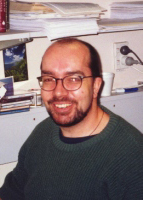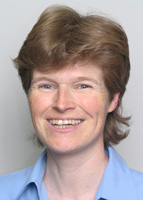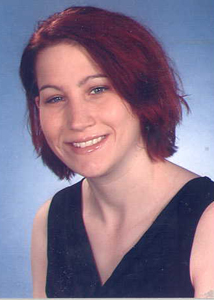Auckland Data Centre




Ulm Data Centre




ISAAC International Data Centres
The success of ISAAC as a worldwide initiative has depended upon efficient co-ordination and communication. It has also benefitted greatly from central collation of data for checking and statistical analysis. This section includes reflections from the ISAAC International Data Centre team in Auckland, New Zealand who played these roles for Phases One and Three, and from the ISAAC Phase Two International Co-ordinating and Data Centre in Ulm, Germany.
Phase One and Three (Auckland)
(Tadd Clayton)The ISAAC data centre in Auckland (now known as the ISAAC International Data Centre [IIDC]) was established in 1992-3 with the appointments of Philippa Ellwood and Tadd Clayton in the Department of Paediatrics. The main tasks in the early years of the IIDC were to carry out the quality assurance checks of the data submitted by the Phase One centres, and to review the study methodology used by each centre to identify any cases where centres had failed to follow the ISAAC protocol. Philippa also had an important role in carrying out the data collection for the Auckland Phase One centre and providing support to the field workers in the other New Zealand Phase One centres.
Following the completion of these tasks for most Phase One centres, the IIDC had an important role in the analysis of Phase One data, preparation of data tables, maps and graphs, and preparation of papers for publication. The IIDC also had a similar important role in the preparation of the Phase One ecological analysis papers.
From 1999 the IIDC began to again receive data from the ISAAC Phase Three centres. Similar data and methodology checks were carried out for the Phase Three data. The greater participation in Phase Three meant that these checks did take a longer period than for Phase One and the preparation of publications presenting the Phase Three data did not begin until 2005. Since then the data centre has again been working to analyse and present the Phase Three data. Phase Three also included an environmental questionnaire and there has been a significant further effort required to analyse and present that data.
Phase Two (Ulm)
(Gudrun Weinmayr)In 2001 I listened to the talk given by Stephan Weiland in the course of his application to the Chair of Epidemiology in Ulm - without the slightest idea that the project he presented would become my main research interest for the years to come. In fact I was at the very beginning of transforming a zoologist into a Master of Public Health i.e. in my first year of the 2-year-course in Ulm. The first implication for us was that we would have a new professor in epidemiology who finally arrived in the end of 2001. In my second year, in February 2002, I joined the data centre in Ulm and got very soon to love the work in this international study appreciating deeply this worldwide diversity. My knowledge of asthma and allergies – and of epidemiology - still had to develop. This first phase in Ulm was characterised by the moving from Münster to Ulm and the build-up of the department where on arrival just two technical staff were present. In Münster, Peter Rzehak and others had already developed a detailed coding and data transfer manual as well as a data check routine including the corresponding SAS-programs. The first centres had already sent their data but the main bulk was still to come. All this was moved to Ulm and for us, the Ulm-staff, in the beginning looked like, as you say in German, a “book with 7 Seals” - a riddle wrapped up in an enigma. The magical crystal ball was the “backup of Bernd’s Computer” where supposedly everything was to be found – if you just knew where… Peter introduced me to all this work that was completely new to me and together we continued and were joined in July by our new secretary Clarissa Schönle and in October 2002 by data manager Claudia Pilz (now Dentler) and my fellow student Gisela Büchele. With her extensive past experience in biometry she had developed during her Master’s thesis the procedure on how to analyse the ISAAC bronchial hyperreactivity (BHR) data. She joined us as the BHR-expert additionally bringing in also a strong experience in data management.
In Autumn 2002, organised by Clarissa, we held the ISAAC Phase Two Meeting with representatives from all study centres. It was a very informative and productive meeting and at the same time the exciting opportunity to get to meet all these people you just previously knew from e-mail exchange.
It took about another two years of solid and devoted work to compile the international data set and bring it into a form that could be reliably used for data analysis. In parallel, we had been developing statistical analysis tools to deal with the complexities of the data set, in particular the weighting procedures to take account of the stratified sub-sample used in Phase Two, and to incorporate all these particularities into SAS-Macros to allow the efficient analyses of the numerous centres.
So in 2004 just in time for the final report for the part of the project that had received funding from the EU, we could finally do the first analyses. With these first results we convened the first Meeting of the Phase Two Publication Group which at the time consisted of Stephan Weiland, Erika von Mutius, Bengt Björkstén, Bert Brunekreef, Bill Cookson, Francesco Forastiere and David Strachan. On this Meeting the outline of the publications to follow was developed. Work started with the publication round looking at the association of atopy with the disease outcome – the asthma paper being the first one to be developed fully but also being fuelled at the same time by discussion on the other papers – in collaboration with Hywell Williams and Carsten Flohr, at the time Hywell’s PhD-student, for the eczema paper and with Francesco Forastiere for the rhinitis paper. This was the time when we realised the full importance of the nonatopic part of disease and as well the concomitant variation of the association atopy-disease in the international context that seems to be in part related to the state of affluence of the country.
In the mean-time changes occurred at the data centre: Claudia and Peter left in 2004/2005 and we were joined by Andrea Kleiner for data management, programming and performing statistical analysis and by Gabriele Nagel, a MPH with a medical background who had previously worked with EPIC.
Analyses continued, mainly with the three above papers, the corresponding paper for BHR, and Gabriele starting to look at the influence of breastfeeding on asthma. Also initiated were the Genetics analyses with mainly Jill Cantelmo and Miriam Moffat to be joined later on by Jon Genuneit, a medical doctor that had joined a already during his training in Ulm - initially for his medical doctors thesis.
In February 2007 we got the good news that the asthma paper had been accepted by the AJRCCM – news that, very unusually, were celebrated in the library with a glass of Champagne and reflected all the “heartblood” as you say in German, i.e. the high amount of passion and thought, that Stephan Weiland had devoted to this first scientific output of Phase Two. It was only a month later, after having read the first draft of the Rhinits paper, that he died completely unexpectedly on 19th of March. This shock deeply hit the whole department missing in addition to his excellent scientific guidance his enthusiastic and humane nature.
It left us with the desire to do our very best to continue this central piece of his work in his sense. In this endeavour we were wonderfully supported by the group and in particular by David Strachan who took over the role as Phase Two Coordinator. This helped us markedly not to only complete the work already started with Stephan Weiland but also to embark for new endeavours such as the round of overview papers sparked by Erika von Mutius during a discussion with David and the group in Ulm.
Communications within ISAAC
(Philippa Ellwood)When ISAAC began in 1991, the Auckland centre was one of the first centres to commit to participate in ISAAC and undertake data collection. In 1992, I was appointed as ISAAC research assistant, responsible for the Phase One fieldwork in the Auckland region, which led to overseeing the national data collection for the six New Zealand centres. In 1993, Auckland was established as the ISAAC International Data Centre (IIDC) and appointed Tadd Clayton as Data Manager. In 1993 my responsibilities were expanded to become the IIDC Research Manager which involved coordinating the international centres and ensuring the fieldwork followed protocol. This involved an enormous amount of communication with the centres.
In Phase One the principle method of communication with the Principal Investigators was by fax machine. It is amusing now to reflect on the amount of time spent standing beside the fax machine sending the centre report to collaborators, almost holding one’s breath in case the fax failed to send, (which it did on frequent occasions) and having to start all over again. Tadd also was an ‘avid’ user of the fax machine for his communications regarding the Phase One data checking and had similar experiences. When receiving documents back from the centres we would at times find pages missing due to failed fax attempts from the centres, which was as frustrating to the collaborators as to us in Auckland. As the fieldwork in Auckland was being undertaken I decided to document the methodology used to approach the schools and how it was undertaken in the schools. It became apparent that this information would be useful for other fieldworkers and these guidelines were subsequently circulated to the centres and made available from the ISAAC website (/phases/phaseone/fieldguide/young.html). These have become a useful tool in assisting centres to follow the ISAAC protocol.
For Phase Three, the use of email had gained popularity and communicating with the centre Principal Investigators and collaborators became a lot less difficult. The centre report had been evaluated and was simplified for ease of understanding. This made it a lengthier document, so having email as the predominant mode of document transfer made life for the IIDC much easier (and less breath holding!).
The experience that Tadd and I have had communicating with the Phase One and Three Principal Investigators and collaborators has simply been a privilege. We have built up an amazing rapport with so many people, from so many different ethnically diverse communities. Due to the stability of the Data Manager and Research Manager, this rapport strengthened over time. With the ISAAC English language questionnaire having being translated into 53 languages, it would not be uncommon for misunderstandings to regularly occur. Although these did happen at times, usually about what the IIDC actually required, these were rare and very easily sorted out. It is humbling to have English as our primary language and have collaborators with English as a second language so enthusiastically embrace our language and have the determination to undertake the ISAAC fieldwork in their centre and to adhere to our documentation written in English. The international success of ISAAC is a tribute to the entire ISAAC worldwide collaboration.
My communications with researchers were always concerning the checking of the data for its integrity, consistency and use of valid values. I prepared a report for each researcher on each version of their data which encouraged them to address as many of the unexpected features of their data as possible. The researchers responded to my reports, either providing a new revised version of the data, corrections for me to apply to the data or a statement that no further improvements were possible.
I would like to thank all of the researchers and the members of their teams who I have been in contact with throughout Phase One and Phase Three. Everyone has been extremely helpful and enthusiastic, as well as being patient with the occasional communication difficulty.
